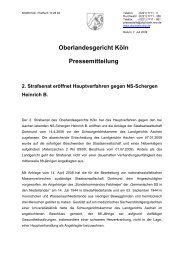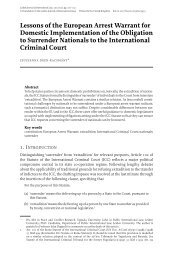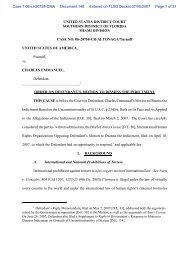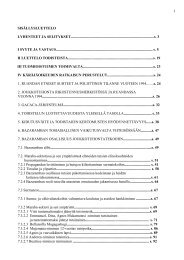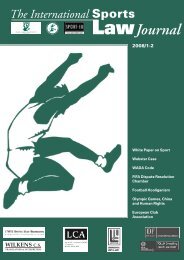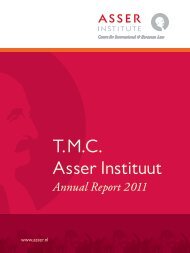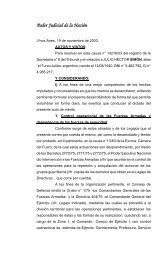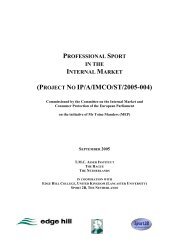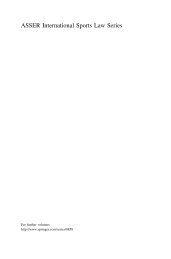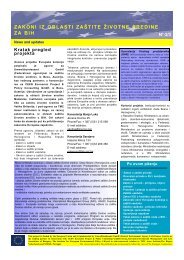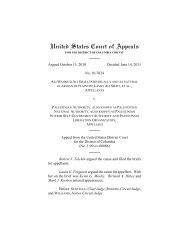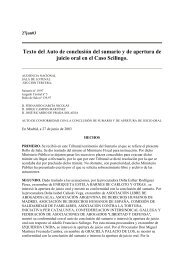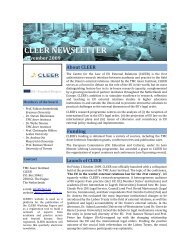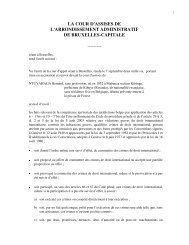Islj 2009 3-4 - TMC Asser Instituut
Islj 2009 3-4 - TMC Asser Instituut
Islj 2009 3-4 - TMC Asser Instituut
Create successful ePaper yourself
Turn your PDF publications into a flip-book with our unique Google optimized e-Paper software.
ever, is not precisely accurate. Brownlie argues that “where [grants of<br />
interest in territory] have been established by agreement the result is<br />
more akin to a contractual licence than it is to an interest in land in<br />
the English sense.” 89 The exact legal effect of these grants and servitudes<br />
and the precise nature of the grantor’s and grantee’s interests can<br />
only be determined by reference to the contractual language establishing<br />
them. 90 The concept which unifies them as a class and distinguishes<br />
them from fully extraterritorial sovereign enclaves is “residual<br />
sovereignty.” Pursuant to the U.S. lease of Guantanamo from Cuba,<br />
for example, the United States recognizes the “ultimate sovereignty”<br />
of Cuba, while Cuba consents to “complete jurisdiction and control”<br />
by the United States. 91<br />
Three principal problems impede the usefulness of this device for<br />
the Olympic enclave. First, these “international” grants, leases or<br />
servitudes are made by contractual arrangement between sovereigns.<br />
It is because one state grants land to another that the agreement falls<br />
under the purview of international law. As will be discussed at<br />
length, 92 the IOC is not a State and does not have the legal capacity<br />
to accept this sort of sovereign interest. Second, the status of these<br />
agreements under international law is uncertain, If they are interpreted<br />
as a simple contractual interest in land, then they may be subject<br />
to unilateral termination by the grantor. 93 Third, and most fundamentally,<br />
all of the objections against the previous option apply here.<br />
This device gives the IOC too much responsibility and requires it to<br />
assume the governmental burdens of sovereignty unnecessarily. 94<br />
C. Internationalized Area<br />
A wide variety of juridically distinct entities can be considered “internationalized<br />
areas.” 95 They include Shanghai 96 and Tangier, 97 both<br />
established before World War I, and Alexandretta, 98 Saar, 99 Upper<br />
Silesia, 100 Memel, 101 and Danzig, 102 all established under the League of<br />
Nations. The concept of an internationalized territory was also used<br />
in U.N. proposals regarding Trieste 103 and Jerusalem. 104 Although<br />
these legal regimes differ significantly, all involve the creation of certain<br />
rights of autonomy vis-à-vis the territorial sovereign from which<br />
they are carved and the vesting of those rights in a public international<br />
organization or in two or more other states, 105 Among examples of<br />
the former, Danzig and Trieste were both created by multilateral<br />
treaty and placed under the direct authority of the League of Nations<br />
and the U.N. Security Council respectively. 106 The plans were never<br />
implemented. Notwithstanding the formal internationalization of the<br />
territorial sovereignty, the Permanent International Court of Justice<br />
held that Danzig possessed an international personality and the legal<br />
capacities of a state. 107<br />
An example of internationalization which was not made universal<br />
through an international organization, but was limited to a smaller<br />
group of states, is the international city of Tangier. Under its 1914<br />
statute, 108 the municipality was granted extensive legislative and diplomatic<br />
authority, although ultimate sovereignty was reserved to the<br />
Sultan. The participating states shared that expanded municipal<br />
authority. 109 Although difficult to label, one scholar described the<br />
arrangement as “a sort of condominium between the Sultan and the<br />
Powers,” or as “an international protectorate.” 110<br />
Although interesting academically, none of these precedents is valuable<br />
for the design of an Olympic enclave. First, the concept of internationalization<br />
was designed for a very different end. The most thorough<br />
investigator of international territories concluded that, by definition,<br />
they include populated areas. 111 They usually were crafted to<br />
bring political autonomy to a persecuted minority or to neutralize a<br />
territory for political or military purposes. Second, the historical failure<br />
of the device to achieve these ends indicates that the device should<br />
be avoided. 112 Some contemporary scholars go so far as to assert that<br />
‘internationalization” has ceased to be a recognized concept in international<br />
law. 113 Finally, the effect of internationalization - bringing the<br />
area directly under the control of a highly political international<br />
forum similar to the United Nations - is exactly what the neutral site<br />
scheme seeks to avoid. The independence and neutrality of the IOC<br />
would be severely compromised.<br />
D. Contractual Guaranty of Limited Autonomy<br />
The final device, contractual agreement between the forum state and<br />
the IOC, may provide the functional privileges and immunities needed<br />
for an autonomous Olympic site. The headquarters agreements of<br />
intergovernmental international organizations (IGOs) generally take<br />
this form. 114 The site remains under the territorial sovereignty of the<br />
forum state. Thus, this arrangement requires neither the fiction of<br />
32 Martens Nouveau Recueil 2d 89<br />
(1905). See generally L. Mills, British Rule<br />
in Eastern Asia 373 (1942).<br />
89 Brownlie, supra note 82, at 372.<br />
90Id. at 115-16.<br />
91 Agreement for the Lease of Lands for<br />
Coaling and Naval Stations, Feb. 16-23,<br />
1903, United States-Cuba, art. III, 192<br />
Parry’s T.S. 429, 430. See generally<br />
Montague, A Brief Study of Some of the<br />
International Legal and Folitical Aspects<br />
of the Guantanamo Bay Problem, 50 Ky.<br />
L.J. 459 (1962).<br />
92 See notes 157-212 and accompanying text<br />
infra.<br />
93 Brownlie, supra note 82, at 116. “[T]he<br />
grantor’ bas a right to revoke the ‘contractual<br />
license,’ and, after a reasonable<br />
time has elapsed, force may be employed<br />
to evict the trespasser.” Id.<br />
94 See text accompanying note 86 supra.<br />
95 Brownlie, supra note 82, at 63-64.<br />
96 See Rules of Procedure of the<br />
International Mixed Court, reprinted in<br />
A. Kotenev, Shanghai: Its Mixed Court<br />
and Council 321 (1925). See generally<br />
Hudson, The Rendition of the<br />
International Mixed Court at Shanghai,<br />
21 Am. J. Int’l L. 451 (1927).<br />
97 ProtectorateTreaty, Mar. 30, 1912, France-<br />
Morocco, 106 Brit. & For. State Papers<br />
1023, 216 Parry’s T.S. 20. The convention<br />
was revised in 1923. Convention regarding<br />
the Organisation of the Statute of the<br />
Tangier Zone, Dec. 18, 1923, France-<br />
Great Britain-Spain, 28 L.N.T.S. 541. See<br />
generally G. Stuart, The International<br />
City of Tangier (2d cd. 1955) [hereinafter<br />
“Stuart”]; Hudson, The International<br />
Mixed Court of Tangier, 21 Am. J. Int’l L.<br />
231 (1927).<br />
98 See Statute of the Sanjak of Alexandretta,<br />
May 29, 1937, 18 League of Nations O.J.<br />
580 (1937). See generally Basdevant, La<br />
question du Sandjak d’Alexandrette et de<br />
d’Antioche, 19 Revue dc Droit<br />
International et de Legislatiori<br />
Comparée 661 (1938).<br />
99 See Treaty of Versailles, June 28, 1919,<br />
arts. 45-50, 225 Parry’s T.S. 189, 213-15,<br />
reprinted in Major Peace Treaties of<br />
Modern History 1648-1967, at 1296-99<br />
(F. Israel cd. 1967). See generally M.<br />
Florinsky, The Saar Struggle (1934).<br />
100Convention for Establishing a<br />
Conventional Regime in Upper Silesia,<br />
May 15, 1922, Germany-Poland, 118 Brit.<br />
& For. State Papers 365. See generally G.<br />
Kaeckenbeeck, The International<br />
Experiment of Upper Silesia (1942).<br />
101 See Convention Concerning the<br />
Territory of Memel, May 8, 1924, 29<br />
L.N,T.S. 85 (1924). See generally The<br />
Status of the Memel Territory, League of<br />
Nations Doc. C.159 M.39 1924 VII<br />
(1924).<br />
102Treaty of Versailles, June 28, 1919, arts,<br />
100-08, 225 Parry’s T.S. 189, 246-49,<br />
reprinted in Major Peace Treaties of<br />
Modern History 1648-1967, at 1338-41 (F.<br />
Israel ed. 1967). See generally J.<br />
Makowski, La situation juridique du territoire<br />
de la Ville Libre de Dantzig<br />
(1925).<br />
103 See Italian Peace Treaty, Feb. 10, 1947,<br />
Italy-Allied Powers, Annex VI,<br />
Permanent Statute of the Free Territory<br />
0f Trieste, 49 U.N.T.S. 72, reprinted in<br />
Major Peace Treaties of Modern History<br />
1648-1967, at 2479-90 (F. Israel ed.<br />
1967). See generally M. Ydit,<br />
Internationalised Territories from the<br />
“Free City of Cracow” to the “Free City<br />
of Berlin” 231-72 (1961) [hereinafter<br />
“Ydit”].<br />
104See G.A. Res. 181 (II), UN. Doe. A/519,<br />
(1947). The resolution called for the creation<br />
of a “special international regime”<br />
under the direct control of the<br />
Trusteeship Council. See generally Ydit,<br />
supra note 103, at 273-315. The<br />
Trusteeship Council prepared a “Draft<br />
Constitution’’ for Jerusalem. See<br />
Question of an International Regime for<br />
the Jerusalem Area and Protection of the<br />
Holy Places, 5 UN. GAOR Supp. (No.<br />
9), UN. Doc. A/1286 (1950).<br />
105 Brownlie, supra note 82, at 55. See Ydit,<br />
supra note 103, at 21.<br />
106106, Ydit, supra note 103, at 50-51, 71-72.<br />
107Free City of Danzig and the<br />
International Labour Organisation (Pol.<br />
v. Free City of Danzig), 1930 P.C.I.J., ser.<br />
B, No. 18 (Advisory Opinion of Aug.<br />
24); Treatment of Polish Nationals and<br />
Other Persons of Polish Origin or<br />
Speech in the Danzig Territory (Pol. v.<br />
Free City of Danzig), 1932 P.C.I.J., ser.<br />
Af B, No. 44, at 23-24 (Advisory<br />
Opinion of Feb. 4).<br />
108See note 97 supra.<br />
109On November 14, 1911, Sir Edward Grey<br />
wrote to the French minister in London<br />
that “just as France stands for the<br />
Sultan’s authority in the French zone,<br />
and Spain in the Spanish zone, so the<br />
Treaty powers collectively shall stand for<br />
the Sultan’s authority in Tangier and its<br />
district.” Documents Diplomatiques<br />
Français (1871-1914), 3d Series (1911-<br />
1914), Vol. No. 348, quoted in Stuart,<br />
supra note 97, at 59-60.<br />
110 Stuart, supra note 97, at 182.<br />
111 Ydit, supra note 103, at 21.<br />
112 See id. at 11.<br />
113 See, e.g., Crawford, supra note 83, at 160.<br />
114 See, e.g., Agreement Regarding the<br />
Headquarters of the United Nations,<br />
June 26, 1947, United States-United<br />
Nations, 61 Stat. 3416, T.I.A.S, No. 1676<br />
(entered into force Nov. 21, 1947) thereinafter<br />
“U.N. Headquarters Agreement];<br />
Agreement Regarding the Headquarters<br />
of the International Atomic Energy<br />
Agency, Dec. 11, 1957, International<br />
Atomic Energy Agency-Austria, 339<br />
U.NT.S. 152 (entered into force Mar. 1,<br />
1958) [hereinafter “IAEA Agreement”];<br />
Agreement Regarding the Headquarters<br />
of the Food & Agriculture Organization,<br />
152 <strong>2009</strong>/3-4<br />
H I S T O RY



